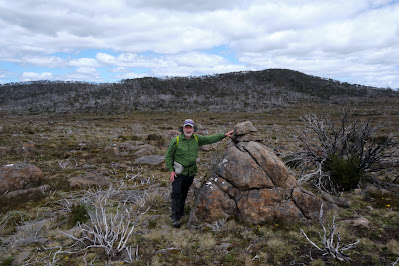We’re lulled to sleep by a frog symphony. Urged on by their own inscrutable drives, they variously bleat, creak and croak through the night to an audience that wouldn’t normally include us. But we’re here, and what a privilege it is to have these calls dampen the din of our normal lives.
The morning breaks fine, with a cloud cover that harbours no threats. We have a slow brew and breakfast, chatting easily about many things before eventually turning to the topic of “where to now?” South is the general answer, with maybe a visit to Lake How and a wander to a high point a little west of there.
 |
Tim eyes the peaks of the Overland Track |
We take a meandering route to the lake, heading first to “the grandstand”. We’ve visited this high point before, and been stunned by the views. Again it doesn’t disappoint. We can clearly see almost every mountain of the Overland Track, from Cradle to Olympus. To the south-east are the high points of the Walls of Jerusalem, and north and east many more mountains, including Tim’s home peak of Mount Roland.
 |
Reflections in a pool beside Lake How |
Within an hour we’re standing by the shallow shores of Lake How. As pleasant as it is, we’re glad we didn’t tried to camp here. It’s a shallow scoop in a soggy, grassy plain, unprotected by bush or trees. We have a scroggin break and discuss our onward route. I’m pretty much in Tim’s hands, having not been this far before. We decide to climb a nearby hill and the ridge beyond it, to reach the probable high point of the Februaries, to the west of the lake.
 |
Towards the Overland Track from the Februaries' high point |
When we get there we again find exhilarating views. The deep valley of the Forth River lies between us and the Overland Track. Our equivalent latitude is well south of Barn Bluff, which we can see clearly. We stop for a very early lunch, and reminisce about walks we’ve done in these nearby mountains. For Tim it’s a significant anniversary: three years since a cardiac arrest on the side of Mount Roland almost ended his life. As we look at Barn Bluff we recall him having, in hindsight, what was probably a warning episode. When we were climbing the steep bluff, Tim was straggling behind when he would normally be leading. At the time he put it down to having given blood the day before we left. Now, by-pass and other surgery behind him, Tim is back to his best, and I’m grateful to be the one straggling behind.
We decide today will be a short day, and amble downslope, thinking we’ll loop back to our home lake for an early finish. But as we cross the shallow valley above Lake How, we make an odd discovery. On the valley flanks, on no obvious route, is a large rock cairn. We puzzle over it, wondering if it’s random, or linked to others. As we walk out of the valley we find another and then, a little further on, two more.
I’ve thought for some time about Frédéric Gros’ theory: that walking through such landscapes detaches us from daily trivia. I’ve certainly experienced the truth of that, but I’ve also pondered what happens to us after we’re detached. Gros hints at us then becoming attached to that which matters. We’ve experienced some of that at our lakeside camp, and elsewhere on this walk. But I think the freed up mind is also now open to uncovering – or discovering – things which have been hidden from us by our cluttered minds.
 |
One of the probable Stock Route cairns |
 |
Tim logs another possible cairn |
We dutifully stop at each one, and Tim enters their GPS coordinates into his device. We photograph some too, noting that they’re far less elaborate, and less covered with lichen, than the cairns we followed on Ritters Track, east of the Walls of Jerusalem, last year. You can read more here: Ritters Track
This kind of discovery becomes quite addictive, and we describe a wider arc than we otherwise might have as we walk on to “just one more” cairn. Eventually we cut back to our home lake, but with the idea that we may try to resume the cairn search on our last day. However when we get back to our tents, Tim’s explorer blood is still bubbling. Given it seems to be a day of discovery, he’s all for trying to find signs of another 19th century track, that of E.G. Innes. This is thought to be on the eastern edge of the Februaries, perhaps a few hundred metres from our lake. By now I’ve taken my boots off, so I only follow part of the way, and soon bow out to photograph the nearby flora. Given their subtle beauty, that will be discovery enough for me.
 |
Rubus gunnianus (Tasmanian alpine raspberry) |
No comments:
Post a Comment